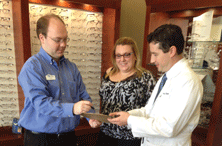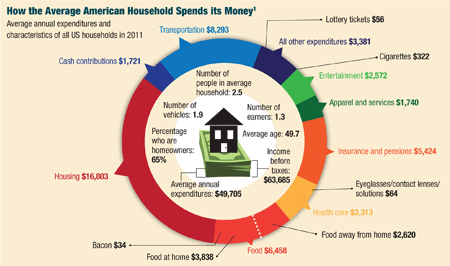A few years ago, one of our patients came into the office wearing a neck brace. He was a 58-year-old computer programmer who just had neck surgery, and he was clearly in a lot of pain.

All three parties—optician, patient and doctor—are involved in the patient handoff. This way, the patient clearly hears the doctor’s recommendations to the optician.
At his last exam three years before, we had prescribed everyday progressive lenses, which were now severely scratched and the frames were held together with Super Glue. His surgeon had told him that poor ergonomics at the computer probably caused his initial problem, which led to the surgery.
As he told us his story, we couldn’t help but think: Did we cause this—maybe? If we had been more adamant about prescribing computer glasses, could he have postponed this outcome? So, following his refraction at this most recent visit, we prescribed four pairs of glasses for his different work environments.
Since the experience we had with this patient, we don’t hesitate to prescribe the products that best serve our patients’ interests. In the last few years, we’ve transitioned into a very patient-oriented practice that prescribes the best products: daily contact lenses, corneal reshaping lenses, vitamins, digital progressives, anti-glare lenses, polarized sunwear and computer glasses.
Here are a few lessons that we’ve learned about the sales process and serving our patients.
Forget Traditional Upselling
When we think of a salesperson, we often think of a pushy guy trying to convince a customer that she needs something that has little value to her. No one wants to be sold something they don’t want or need. Traditional upselling with an old-school, used car salesman approach doesn’t work, and isn’t appreciated.
Instead, train your salespeople to be educated ophthalmic professionals. This new breed of salesperson knows that patients can find tons of information about their products online. Some patients may already be more educated about the product than the staff member, so your staff must be aware of all of the advantages and disadvantages of a product and be ready to discuss them openly.
In addition to informing a patient fairly, your staff should be friendly with the patient. You don’t have to hang out with patients after they leave the office, but you should be able to smile and say hello if you see them around town. You have to be genuinely interested in them, ask them what they do and listen to the response. Then when you prescribe the products the patient needs, use the knowledge that you’ve gained to help pinpoint your recommendations.
Ask yourself this question before you make a sale: Will the patient’s life improve from purchasing this product? You want to make this patient happy not just at that moment, but you want to turn them into a loyal, returning patient who refers family and friends

Money Isn’t the Problem
Good economy or bad, your patients spend their money on lots of items that are less valuable than the products and services that you offer. Consider that an average household spends its money on loads of frivolous items, such as:1
- Dining out—$2,620 per year
- Entertainment—$2,572 per year
- Cigarettes—$322 per year
- Lottery tickets—$56 per year
- Bacon—$33.87 per year
Compare these purchases with the average household’s expense of eyeglasses and contact lenses—$63.53 per year, which includes saline and solutions!
Which do you think is better for your patients: a nice pair of backup glasses (for when they’re not wearing their contacts) or a few slices of bacon?
Of course, eye care professionals shouldn’t decide for their patients what they can or can’t afford But the fact is that most of your patients make bad financial decisions every day.
The products that we prescribe for them actually improve their lives. When you think about it, the cost of adding photochromic or anti-glare lenses for the life of the glasses is rather inexpensive. A pair of value-added glasses only costs a dollar or two per day for just one year.
The Economy
When we ask our colleagues about add-on items like second pairs, anti-glare or photochromic lenses, they almost always blame the economy for poor sales. Even some of the wealthiest patients complain about how they can’t afford new glasses because of the bad economy. Yes, it is easier to get patients to purchase the best products that fit their needs in a strong economy, but many eye care professionals don’t even offer the best products to their patients in tough times.
Ignore the economy. You can’t fix it.
Don’t let the overall economic condition impact the performance of your office, and definitely don’t let it dictate the best products for your patients.
Your physician would never look at your insurance benefits and then decide what medication to prescribe. So, why do optometrists let their patients sway their decisions on what to prescribe?
Always prescribe the best products, as long as you always explain why you’re prescribing it. Here’s an example:
“Ms. Jones you have allergies and you wear your two-week contact lenses for a month. I’m concerned about how long you’ll be able to wear contacts lenses because contact lens drop out is a common problem when patients over-wear their lenses. So, I recommend daily disposables, which will not only be better for your allergies, but will decrease your risk of not being able to wear contact lenses at all.”
You owe it to your patients to let them know what’s available and what’s best for them. So always make the offer.
Give Them What They Want
Many patients prefer to be prescribed the best products no matter what the cost. And some patients may desire to buy better products, but they just aren’t sure; they need a little reassurance from the doctor that it will help them.
Patients don’t want the process to be confusing, so simply asking if they want product X is the wrong approach. People appreciate service and education, so listen to them. Patients want to be told/prescribed the best products—they’ll inform you if they have cost objections, but you should not let this deter you from at least offering your recommendations.
Once the doctor has given the patient “permission” to buy—by prescribing the best products that the patient would want to have anyway—then the optician’s job is rather easy. All an optician needs from an optometrist in the patient handoff is this: “Ms. Jones needs X, Y and Z, and I would like to see her again in a year.” This step is crucial in smoothly moving the patient from the exam room to the optical and is to be done as a group: doctor, optician and patient. This accomplishes two important objectives: The patient hears your recommendations again in front of the optician, and the patient now knows that the optician is going to carry out your recommendations. The optician then will demonstrate the prescribed products and make further recommendations from there.
Not only will your patients appreciate a clear understanding of your recommendations, your practice will enjoy the guaranteed increase in capture rate.
Customer Service is a Must
Customer service is the key component in thinking about what is best for the patient and your office. When you approach an obstacle or an encounter with the best needs of the customer in mind, it creates a win-win for you and the patient.
You want to create a customer service culture in your office. We talk about customer service at our office meetings—not just the good customer service but the bad stuff as well. We give out customer service awards for staff members who go above and beyond their job description. For example, last week one of our opticians went and purchased two Happy Meals for children who had waited a long time to see the doctor. This unsolicited gesture came out of his own pocket. I guarantee this will be brought up at our next meeting. To quote a local optician, Jim Dundee of Belleair Opticians, “Being nice is free.”
The Big Picture
The key to this story is to prescribe all of the necessary products and let the patients decide for themselves. Do not decide for the patients—this is the biggest mistake that most optometrists make. Simply prescribe what you know is the healthiest and best products for your patients, and give them the choice.
Generally speaking, patients visit an ECP every year or two, and don’t always remember from one visit to the next what questions they should ask to get the best products. New products may have arrived, so each year we get to reeducate our patients, listen to them and get them the products they need.
Unfortunately, people often remember the office visit by the products they left with, not the exam. So, how will your patients feel about your office when they look at their glasses in six months? Do your best that they won’t look back with regret.
Mr. Whaley is a licensed optician and the practice manager at The EyeDoctors in Tampa, Fla., and Dr. Teske is the founder and owner of The EyeDoctors. They are co-owners of Turn Key Optometry Consulting.
1. Consumer Expenditure Survey 2011. Bureau of Labor Statistics, US Department of Labor. Data available at: www.bls.gov/cex. Accessed February 14, 2013.

